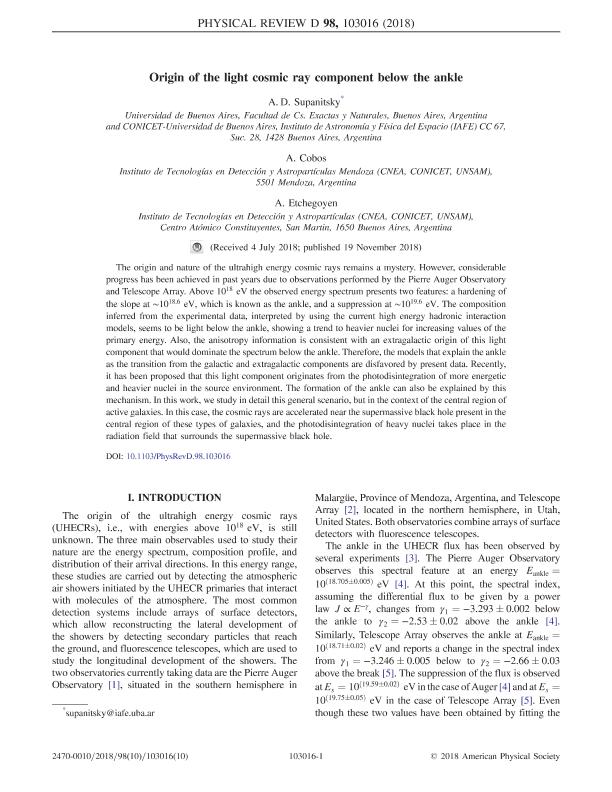Artículo
Origin of the light cosmic ray component below the ankle
Fecha de publicación:
11/2018
Editorial:
American Physical Society
Revista:
Physical Review D: Particles, Fields, Gravitation and Cosmology
ISSN:
2470-0029
Idioma:
Inglés
Tipo de recurso:
Artículo publicado
Clasificación temática:
Resumen
The origin and nature of the ultrahigh energy cosmic rays remains a mystery. However, considerable progress has been achieved in past years due to observations performed by the Pierre Auger Observatory and Telescope Array. Above 1018 eV the observed energy spectrum presents two features: a hardening of the slope at ∼1018.6 eV, which is known as the ankle, and a suppression at ∼1019.6 eV. The composition inferred from the experimental data, interpreted by using the current high energy hadronic interaction models, seems to be light below the ankle, showing a trend to heavier nuclei for increasing values of the primary energy. Also, the anisotropy information is consistent with an extragalactic origin of this light component that would dominate the spectrum below the ankle. Therefore, the models that explain the ankle as the transition from the galactic and extragalactic components are disfavored by present data. Recently, it has been proposed that this light component originates from the photodisintegration of more energetic and heavier nuclei in the source environment. The formation of the ankle can also be explained by this mechanism. In this work, we study in detail this general scenario, but in the context of the central region of active galaxies. In this case, the cosmic rays are accelerated near the supermassive black hole present in the central region of these types of galaxies, and the photodisintegration of heavy nuclei takes place in the radiation field that surrounds the supermassive black hole.
Palabras clave:
Cosmic rays
,
Light component
Archivos asociados
Licencia
Identificadores
Colecciones
Articulos(ITEDA)
Articulos de INSTITUTO DE TEC. EN DETECCION Y ASTROPARTICULAS
Articulos de INSTITUTO DE TEC. EN DETECCION Y ASTROPARTICULAS
Citación
Supanitsky, Alberto Daniel; Cobos, A.; Etchegoyen, Alberto; Origin of the light cosmic ray component below the ankle; American Physical Society; Physical Review D: Particles, Fields, Gravitation and Cosmology; 98; 10; 11-2018; 1-10; 103016
Compartir
Altmétricas




